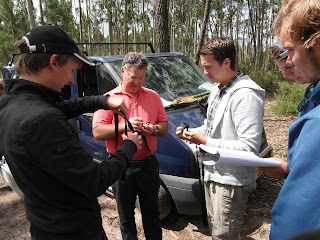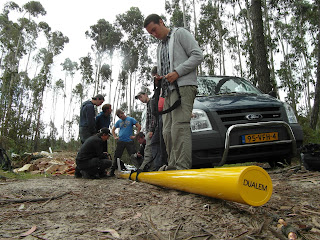“I don't feel like eating much here,
when I eat too much I start feeling sick” said
Corné just before the grilled rabbit, ordered by Bob, arrived at our
table. I was ready to get a bit worried, but when the waiter asked
Corné if he wanted some more, there was no sign of him feeling sick
when he nodded enthusiastically and said that this was nice. Rosa
(vegetarian) just shook her head. This all happened after a
sometimes smelly day at the garbage dump.
But
let's start a bit earlier with the quest for pumping test locations
by the Tabuaço and Mesas groups. But you innocent reader of this
blog might ask, what in the world is a pumping test? Well, in short,
it is us making two tubes in the soil (called piezometers by
hydrologists) that both go into the groundwater, putting a pump in
one of the tubes, switch it on and then monitor the change in water
level in the other piezometer. There are a few things that matter,
one is that you need to be able to pump enough water out, so the soil
should be sandy and deep enough to provide this. And that is exactly
where things can get messy. We started with an existing piezometer
near Tabuaço village, which was in sandy soil. So the group started
augering away and describing the soil that came out.
 |
| Soil description from an auger hole - intra-team work |
But suddenly, oh no, Cretaceous clay entered the auger hole sample! How was this possible? Michel went to investigate just behind the hill where we were augering away and found the reason. The groundwater was above the caly and there would never be enough water there to do a pumping test. On the other hand, we found a beautiful contact spring.
 |
| Contact spring where the Quaternary sand was lying on top of impermeable C5 Cretaceous clay |
Unabashed by this unsuccessful attempt at doing a pumping test there, Jet suggested to do one at a piezometer they had just installed in the Mesas area. As far as the group remembered, the soil was sandy enough to succeed there. So of we were to mesas. One part of the group again put the auger to work, whereas the other group aimed to estimate the clay depth. This because the site was close to the village of Montouro, which is known for its lack of water because of the closeness of the clay to the surface. So the EM34 geophysical instrument was taken out of the car and put to measure.
 |
| Mesas and Tabuaco teams doing geophysics before attempting to make a pumping well. |
In the mean time work on the pumping well started and the first water was taken from the hole with the bailer. Then the hole started to sound dry and the soil became very sticky. Clay was also confirmed by the EM34 and by the large diamters of the wells in the area. Bummer, again clay messed up their plans for a pumping test, so they decided to go ahead with ring infiltrometer measurements, rather than try pumping from their clayey soils. Sometimes you learn more from a failed pumping test than from a successful one!
So fast forward to today again. We had plans for the garbage dump. These were daring and included the first testing of Michel's new toy, the DUALEM-4 electromagnetic geophysical sensor, doing a Continuous Vertical Electrical Sounding to see if the dump pollution plume had cleaned up, and performing a pumping test, all in one day. Eat this! Now, there are very few MSc students in the world who may use a $48,000 Dualem - new from the box - in a field course. Most supervisors would turn pale, shiver and tremble with fear at this taught. Not us. So there Bob, Vince, Anne, Thomas, Joris and Robbert went of with the $48,000 yellow tube to study the secrets of the dump site.
 |
| Instruction by Michel into the operation of a brand-new Dualem instrument (the not so fancy-looking yellow tube). |
After some practicing our students got the hang of it and measured a few transects, stopping every 5 m to do measurements.
 |
| Anne marking next measuring location, Bob working the controller and Vince and Robbert carrying the Dualem-4 |
While this was going on, Joris and Corné hammered on elctrodes and the CVES Terrameter was started to compare results with the DUALEM measurements.
Finally, one thing remained, which was the pumping test. Here we were in sandy soil and had a pumping well available from last year. Pump installed, datalogger for monitoring started, Maarten swallowing a mouthfull of dirty garbage-lake pump-priming water as lunch to get the flow going and pumping started. Water in the monitoring well went down very fast and fear built up as wether our monitoring sensor would remain below water (it did). Bob digging ditches as pump water was measured to know the pump capacity.
 |
| Determining pump capacity for the aquifer transmissivity test |
Now it was seven o'clock and a few of the crew started to get hungry, but at the same time their mind was not at cooking. So we decided to eat dinner at Fornos, a small restaurant in Costa Nova. And that's where Bob's rabbits came in... Tomorrow, new findings in Sao Romao!
































